Modeling of Compressive Strength for Unidirectional Fiber Reinforced Composites with Nanoparticle Modified Epoxy Matrix
Abstract
:1. Introduction
2. Modeling
2.1. Microbuckling Model with Plasticity and Damage of Polymer Matrix
2.2. Constitutive Model of Nanocomposite Matrix
3. Experimental Verification
3.1. Materials and Sample Preparation
3.2. Characterization and Mechanical Tests
4. Results and Discussion
4.1. Compressive Stress-Strain Relation of Nano-SiO2/Epoxy Matrices
4.2. Compressive Strength of CF/Nano-SiO2/Epoxy Composites
5. Conclusions
Author Contributions
Funding
Conflicts of Interest
Appendix A. Microbuckling Model for Unidirectional Fiber Reinforced Composites Influenced by Plasticity and Damage of Matrix

References
- Soutis, C. Measurement of the static compressive strength of carbon-fibre/epoxy laminate. Compos. Sci. Technol. 1991, 42, 373–392. [Google Scholar] [CrossRef]
- Bedon, C.; Louter, C. Structural glass beams with embedded GFRP, CFRP or steel reinforcement rods: Comparative experimental, analytical and numerical investigations. J. Build. Eng. 2019, 22, 227–241. [Google Scholar] [CrossRef]
- Naik, N.K.; Kumar, R.S. Compressive strength of unidirectional composites: Evaluation and comparison of prediction models. Compos. Struct. 1999, 46, 299–308. [Google Scholar] [CrossRef]
- Jumahat, A.; Soutis, C.; Jones, F.R.; Hodzic, A. Fracture mechanisms and failure analysis of carbon fibre/toughened epoxy composites subjected to compressive loading. Compos. Struct. 2010, 92, 295–305. [Google Scholar] [CrossRef]
- Rosen, B.W. Mechanics of composite strengthening. In Fiber Composite Materials; American Society of Metals: Cleveland, OH, USA, 1965; pp. 35–75. [Google Scholar]
- Jelf, P.M.; Fleck, N.A. Compression failure mechanisms in unidirectional composites. J. Compos. Mater. 1992, 26, 2706–2726. [Google Scholar] [CrossRef]
- Sun, C.T.; Jun, A.W. Compressive strength of unidirectional fiber composites with matrix non-linearity. Compos. Sci. Technol. 1994, 52, 577–587. [Google Scholar] [CrossRef]
- Berbinau, P.; Soutis, C.; Guz, I.A. Compressive failure of 0° unidirectional carbon-fibre-reinforced plastic (CFRP) laminates by fibre microbuckling. Compos. Sci. Technol. 1999, 59, 1451–1455. [Google Scholar] [CrossRef]
- Leopold, C.; Harder, S.; Philipkowski, T.; Liebig, W.V.; Fiedler, B. Comparison of analytical approaches predicting the compressive strength of fibre reinforced polymers. Materials 2018, 11, 2517. [Google Scholar] [CrossRef]
- Uddin, M.F.; Sun, C.T. Strength of unidirectional glass/epoxy composite with silica nanoparticle-enhanced matrix. Compos. Sci. Technol. 2008, 68, 1637–1643. [Google Scholar] [CrossRef]
- Tsai, J.-L.; Cheng, Y.-L. Investigating silica nanoparticle effect on dynamic and quasi-static compressive strengths of glass fiber/epoxy nanocomposites. J. Compos. Mater. 2009, 43, 3143–3155. [Google Scholar] [CrossRef]
- Subramaniyan, A.K.; Sun, C.T. Enhancing compressive strength of unidirectional polymeric composites using nanoclay. Compos. Part A Appl. Sci. Manuf. 2006, 37, 2257–2268. [Google Scholar] [CrossRef]
- Cho, J.; Chen, J.Y.; Daniel, I.M. Mechanical enhancement of carbon fiber/epoxy composites by graphite nanoplatelet reinforcement. Scr. Mater. 2007, 56, 685–688. [Google Scholar] [CrossRef]
- Khosravi, H.; Eslami-Farsani, R. On the mechanical characterizations of unidirectional basalt fiber/epoxy laminated composites with 3-glycidoxypropyltrimethoxysilane functionalized multi-walled carbon nanotubes–enhanced matrix. J. Reinf. Plast. Compos. 2016, 35, 421–434. [Google Scholar] [CrossRef]
- Ladeveze, P.; Le Dantec, E. Damage modelling of the elementary ply for laminated composites. Compos. Sci. Technol. 1992, 43, 257–267. [Google Scholar] [CrossRef]
- Tandon, G.P.; Weng, G.J. A Theory of Particle-Reinforced Plasticity. J. Appl. Mech. Trans. ASME 1988, 55, 126–135. [Google Scholar] [CrossRef]
- Christensen, R.M. A critical evaluation for a class of micro-mechanics models. J. Mech. Phys. Solids 1990, 38, 379–404. [Google Scholar] [CrossRef]
- Toray T700G Datasheet. Available online: https://www.toraycma.com/file_viewer.php?id=5111 (accessed on 13 April 2018).
- Zhang, H.; Tang, L.; Zhang, Z.; Friedrich, K.; Sprenger, S. Fracture behaviours of in situ silica nanoparticle-filled epoxy at different temperatures. Polymer 2008, 49, 3816–3825. [Google Scholar] [CrossRef]
- Guillonneau, G.; Kermouche, G.; Bec, S.; Loubet, J.-L. Determination of mechanical properties by nanoindentation independently of indentation depth measurement. J. Mater. Res. 2012, 27, 2551–2560. [Google Scholar] [CrossRef]
- Lubineau, G.; Ladevèze, P.; Violeau, D. Durability of CFRP laminates under thermomechanical loading: A micro–meso damage model. Compos. Sci. Technol. 2006, 66, 983–992. [Google Scholar] [CrossRef]
- Kleisner, V.; Zemcik, R.; Kroupa, T. Identification and verification of the composite material parameters for the ladevèze damage model. Mater. Tehnol. 2011, 45, 567–570. [Google Scholar]
- Chaboche, J.L. Continuum damage mechanics: Part I—General concepts. J. Appl. Mech. 1988, 55, 59–64. [Google Scholar] [CrossRef]
- Lubliner, J. Plasticity Theory; Dover Publications: New York, NY, USA, 2008. [Google Scholar]

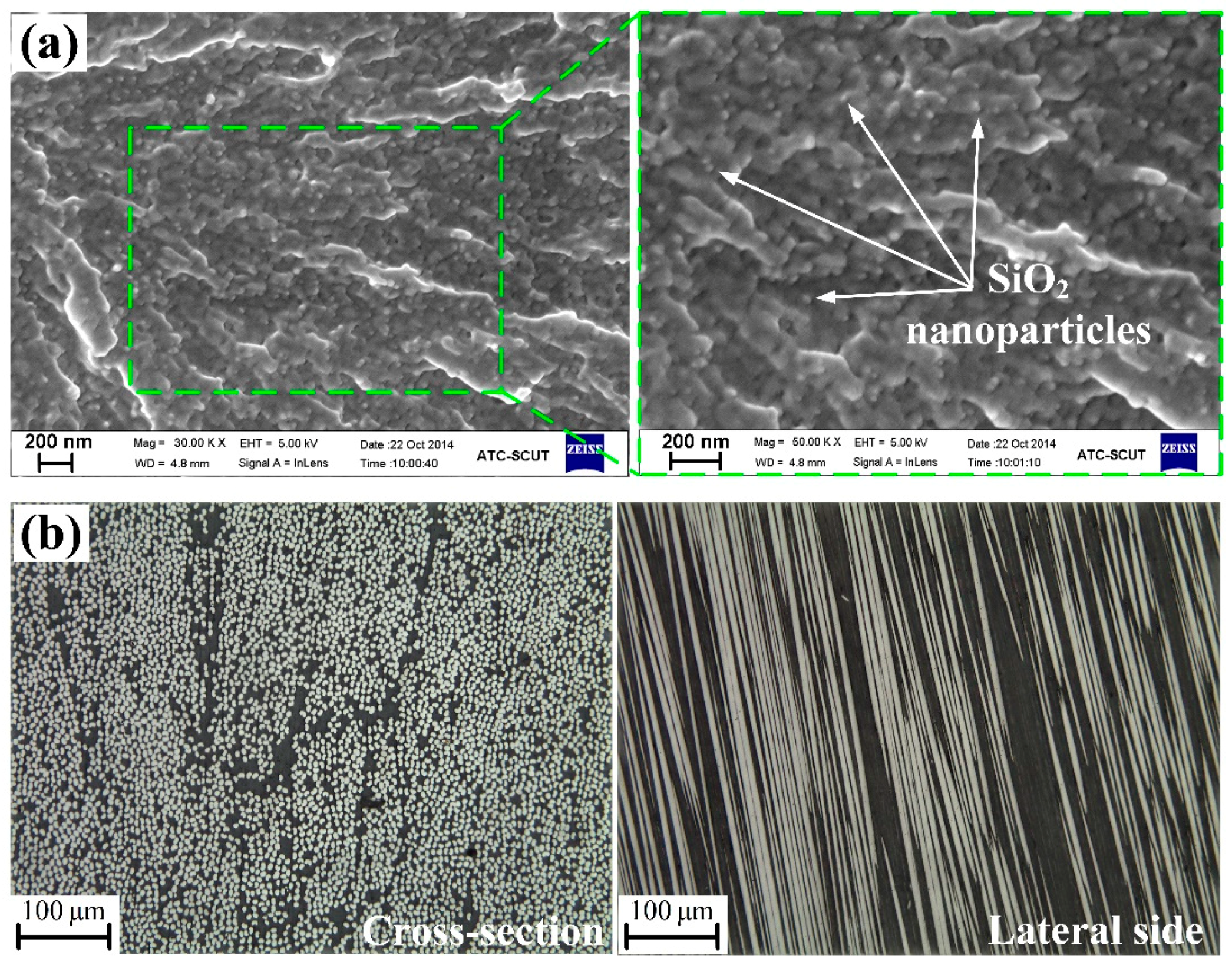
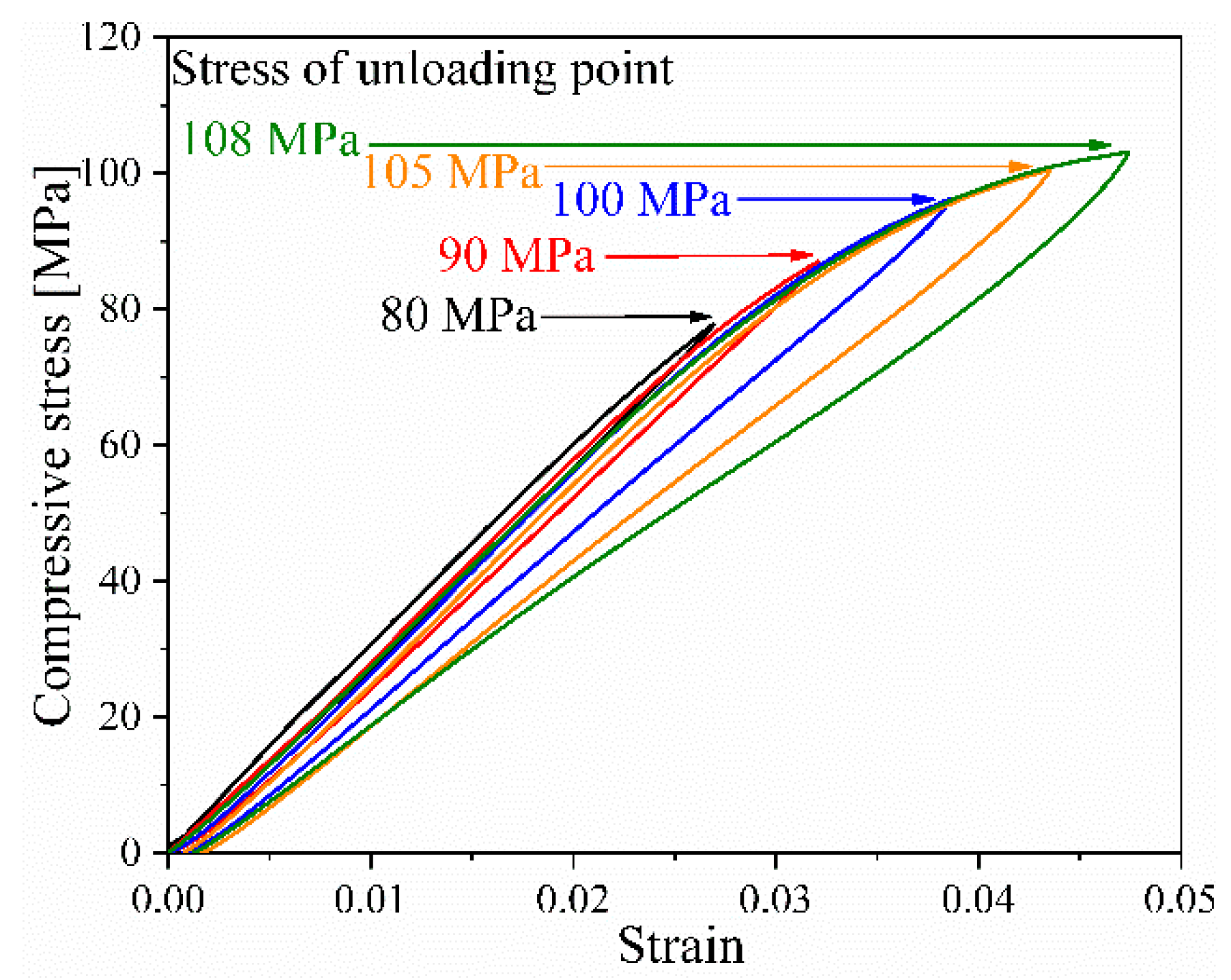
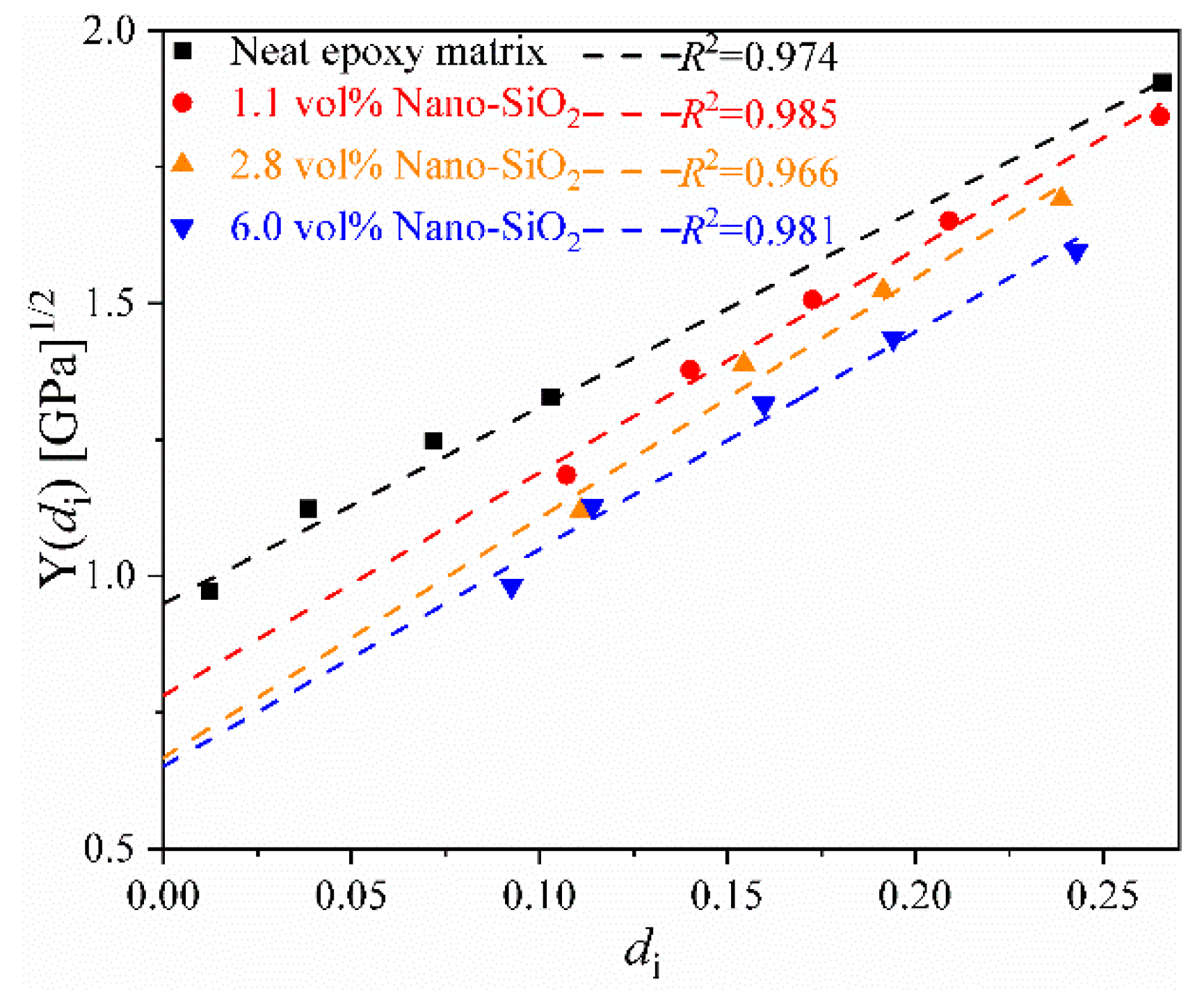

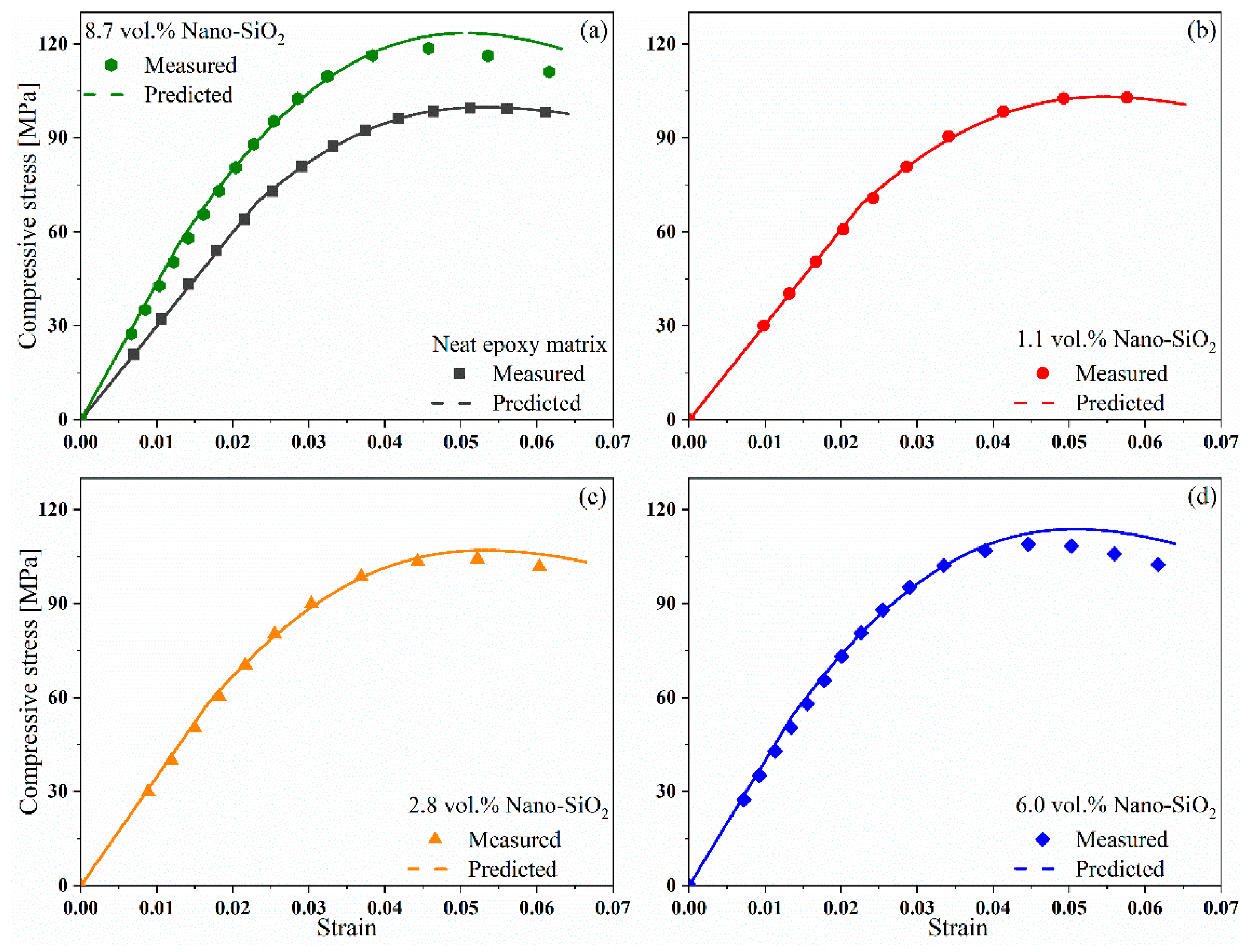
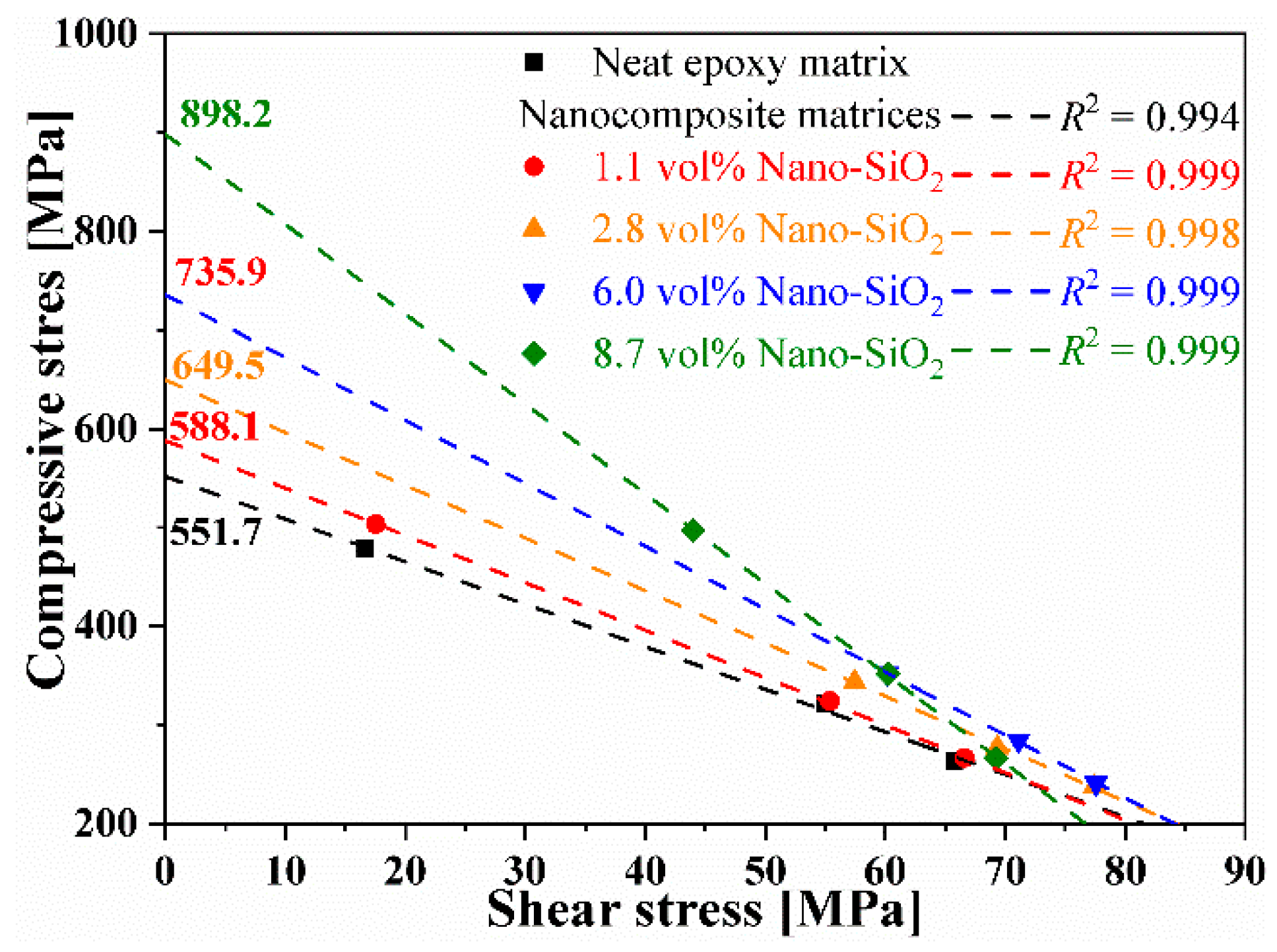

| Nano-SiO2 [vol.%/wt.%] | E51 [Mass Part] | Nanopox F520 [Mass Part] | MHHPA [Mass Part] | BDMA [Mass Part] |
|---|---|---|---|---|
| 0/0 | 100 | 0 | 85.9 | 1.00 |
| 1.1/2 | 100 | 10.1 | 91.9 | 1.10 |
| 2.8/5 | 100 | 29.0 | 103.3 | 1.20 |
| 6.0/10 | 100 | 77.6 | 132.0 | 1.55 |
| 8.7/15 | 100 | 177.7 | 196.1 | 2.54 |
| Nano-SiO2 [vol.%] | Elastic Modulus [GPa] | Relative Improvement [%] | Predicted Modulus [GPa] |
|---|---|---|---|
| 0 | 3.25 ± 0.28 | ||
| 1.1 | 3.37 ± 0.11 | 3.7 | 3.32 |
| 2.8 | 3.51 ± 0.21 | 8.0 | 3.44 |
| 6.0 | 3.69 ± 0.33 | 13.5 | 3.68 |
| 8.7 | 3.87 |
| Nano-SiO2 [vol.%] | [GPa]1/2 | [GPa]1/2 | [GPa] | [GPa] | m |
|---|---|---|---|---|---|
| 0 | 0.042 | 0.31 | 0.12 | ||
| 1.1 | 0.048 | 0.35 | 0.15 | ||
| 2.8 | 0.055 | 0.45 | 0.18 | ||
| 6.0 | 0.071 | 0.59 | 0.22 | ||
| 8.7 | 0.083 | 0.73 | 0.27 |
| Nano-SiO2 [vol.%] | Off-Axial Compressive Strength [MPa] | ||||
|---|---|---|---|---|---|
| 2° | 5° | 10° | 15° | 20° | |
| 0 | 386.3 ± 10.4 | 319.0 ± 20.3 | 263.9 ± 11.8 | 202.2 ± 28.9 | |
| 1.1 | 503.4 ± 47.5 | 391.2 ± 33.9 | 324.1 ± 23.6 | 266.5 ± 17.7 | 190.8 ± 6.4 |
| 2.8 | 514.8 ± 16.3 | 403.8 ± 20.1 | 339.1 ± 17.9 | 280.5 ± 13.6 | 240.8 ± 20.6 |
| 6.0 | 547.4 ± 24.3 | 416 ± 21.4 | 347.9 ± 17.7 | 286.8 ± 18.8 | 241.3 ± 9.8 |
| 8.7 | 569.9 ± 22.5 | 352.1 ± 19.2 | 266.9 ± 16.5 | 219.3 ± 11.5 | |
© 2019 by the authors. Licensee MDPI, Basel, Switzerland. This article is an open access article distributed under the terms and conditions of the Creative Commons Attribution (CC BY) license (http://creativecommons.org/licenses/by/4.0/).
Share and Cite
Chen, W.; Liu, Y.; Jiang, Z.; Tang, L.; Liu, Z.; Zhou, L. Modeling of Compressive Strength for Unidirectional Fiber Reinforced Composites with Nanoparticle Modified Epoxy Matrix. Materials 2019, 12, 3897. https://doi.org/10.3390/ma12233897
Chen W, Liu Y, Jiang Z, Tang L, Liu Z, Zhou L. Modeling of Compressive Strength for Unidirectional Fiber Reinforced Composites with Nanoparticle Modified Epoxy Matrix. Materials. 2019; 12(23):3897. https://doi.org/10.3390/ma12233897
Chicago/Turabian StyleChen, Wei, Yiping Liu, Zhenyu Jiang, Liqun Tang, Zejia Liu, and Licheng Zhou. 2019. "Modeling of Compressive Strength for Unidirectional Fiber Reinforced Composites with Nanoparticle Modified Epoxy Matrix" Materials 12, no. 23: 3897. https://doi.org/10.3390/ma12233897




